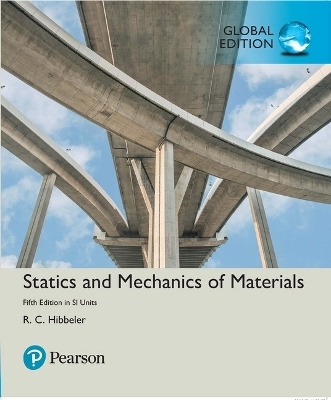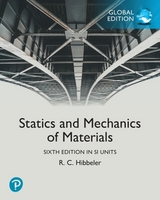
Statics and Mechanics of Materials in SI Units
Pearson Education Limited (Verlag)
978-1-292-17791-5 (ISBN)
Statics and Mechanics of Materials represents a combined abridged version of two of the author’s books, namely Engineering Mechanics: Statics, 14th Edition and Mechanics of Materials, 10th Edition.
It provides a clear and thorough presentation of both the theory and application of the important fundamental topics of these subjects that are often used in many engineering disciplines. The development emphasises the importance of satisfying equilibrium, compatibility of deformation, and material behaviour requirements. The hallmark of the book, however, remains the same as the author’s unabridged versions, and that is, strong emphasis is placed on drawing a free-body diagram, and the importance of selecting an appropriate coordinate system and an associated sign convention whenever the equations of mechanics are applied. Throughout the book, many analysis and design applications are presented, which involve mechanical elements and structural members often encountered in engineering practice.
R. C. Hibbeler graduated from the University of Illinois at Urbana with a BS in Civil Engineering (majoring in Structures) and an MS in Nuclear Engineering. He obtained his PhD in Theoretical and Applied Mechanics from Northwestern University. Professor Hibbeler's professional experience includes postdoctoral work in reactor safety and analysis at Argonne National Laboratory, and structural and stress analysis work at Chicago Bridge and Iron, as well as at Sargent and Lundy in Chicago. He has practiced engineering in Ohio, New York, and Louisiana. Professor Hibbeler currently teaches both civil and mechanical engineering courses at the University of Louisiana - Lafayette. In the past, he has taught at the University of Illinois at Urbana, Youngstown State University, Illinois Institute of Technology, and Union College.
1 General Principles
1.1 Mechanics
1.2 Fundamental Concepts
1.3 The International System of Units
1.4 Numerical Calculations
1.5 General Procedure for Analysis
2 Force Vectors
2.1 Scalars and Vectors
2.2 Vector Operations
2.3 Vector Addition of Forces
2.4 Addition of a System of Coplanar Forces
2.5 Cartesian Vectors
2.6 Addition of Cartesian Vectors
2.7 Position Vectors
2.8 Force Vector Directed Along a Line
2.9 Dot Product
3 Force System Resultants
3.1 Moment of a Force–Scalar Formulation
3.2 Cross Product
3.3 Moment of a Force–Vector Formulation
3.4 Principle of Moments
3.5 Moment of a Force about a Specified Axis
3.6 Moment of a Couple
3.7 Simplification of a Force and Couple System
3.8 Further Simplification of a Force and Couple System
3.9 Reduction of a Simple Distributed Loading
4 Equilibrium of a Rigid Body
4.1 Conditions for Rigid-Body Equilibrium
4.2 Free-Body Diagrams
4.3 Equations of Equilibrium
4.4 Two- and Three-Force Members
4.5 Free-Body Diagrams
4.6 Equations of Equilibrium
4.7 Characteristics of Dry Friction
4.8 Problems Involving Dry Friction
5 Structural Analysis
5.1 Simple Trusses
5.2 The Method of Joints
5.3 Zero-Force Members
5.4 The Method of Sections
5.5 Frames and Machines
6 Center of Gravity, Centroid, and Moment of Inertia
6.1 Center of Gravity and the Centroid of a Body
6.2 Composite Bodies
6.3 Moments of Inertia for Areas
6.4 Parallel-Axis Theorem for an Area
6.5 Moments of Inertia for Composite Areas
7 Stress and Strain
7.1 Introduction
7.2 Internal Resultant Loadings
7.3 Stress
7.4 Average Normal Stress in an Axially Loaded Bar
7.5 Average Shear Stress
7.6 Allowable Stress Design
7.7 Deformation
7.8 Strain
8 Mechanical Properties of Materials
8.1 The Tension and Compression Test
8.2 The Stress—Strain Diagram
8.3 Stress—Strain Behavior of Ductile and Brittle Materials
8.4 Strain Energy
8.5 Poisson’s Ratio
8.6 The Shear Stress—Strain Diagram
9 Axial Load
9.1 Saint-Venant’s Principle
9.2 Elastic Deformation of an Axially Loaded Member
9.3 Principle of Superposition
9.4 Statically Indeterminate Axially Loaded Members
9.5 The Force Method of Analysis for Axially Loaded Members
9.6 Thermal Stress
10 Torsion
10.1 Torsional Deformation of a Circular Shaft
10.2 The Torsion Formula
10.3 Power Transmission
10.4 Angle of Twist
10.5 Statically Indeterminate Torque-Loaded Members
11 Bending
11.1 Shear and Moment Diagrams
11.2 Graphical Method for Constructing
Shear and Moment Diagrams
11.3 Bending Deformation of a Straight Member
11.4 The Flexure Formula
11.5 Unsymmetric Bending
12 Transverse Shear
| Erscheinungsdatum | 28.04.2018 |
|---|---|
| Verlagsort | Harlow |
| Sprache | englisch |
| Maße | 201 x 234 mm |
| Gewicht | 1457 g |
| Themenwelt | Technik ► Maschinenbau |
| ISBN-10 | 1-292-17791-8 / 1292177918 |
| ISBN-13 | 978-1-292-17791-5 / 9781292177915 |
| Zustand | Neuware |
| Haben Sie eine Frage zum Produkt? |
aus dem Bereich



